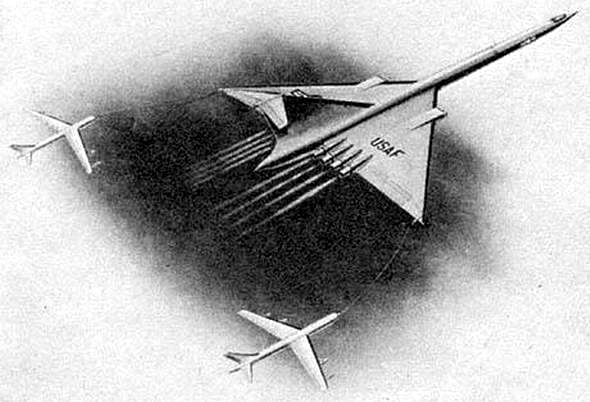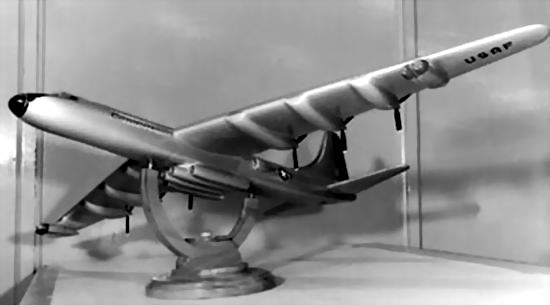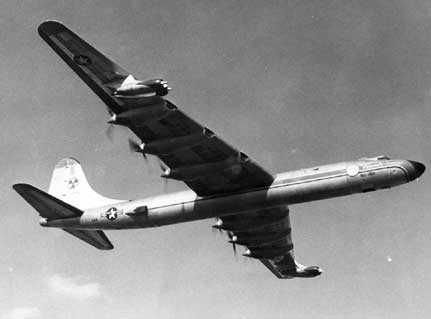JF Ptak Science Books Post 1810
Shooting Down the Nuclear Plane, by W. Henry Lambright, (Inter-University Case Program #104, Bobbs-Merrill Co., 1964), is an interesting and nicely-documented history of an idea whose firm grasp on reality night not be terribly firm. Of course it would be possible to prodce such a thing (at about this same time in 1961 appeared a cover for Popular Mechanics for an atomic-powered car from which two cowboys went a-hunting) if there was the collective will to do so, and there almost was. Let's just say then that the atomic-poweredness of our domestic defense was limited to aircraft carriers and submarines, and the atomic-powererd aircraft were left to science fiction .
In general though it was at this time, from about 1946 thorugh the late 1950s', that people were thinking of refitting standard power systems with atomic energy.
Here are a few ideas for alternative approaches to flight, provided by the happy folks known as Atomic Energy:
Another possibility for a nculear powered aircraft, by Northrup:

[Source] Another interesting design--a nuclear-powered prop plane, X-6, "derived from the Corvair B-36":

[Source]
A chronology, from the report:
"May 28, 1946 - NEPA Project began officially with signing of AAF letter of intent by General Spaatz and Maj. Gen. Leslie Groves. Associated with Fairchild were Allison, United Aircraft, Wright Aeronautical, General Electric, Westinghouse, Continental Aviation, Lycoming, Northrop, Flader and Menasco Mfg. Co. Member companies were to have a voice in technical phases of the NEPA Program and could assign personnel to the working organization. The goal was a feasibility investigation and research leading to the adaptation of nuclear energy as a means of propulsion of aircraft for tactical utility. Letter-contract authorized expenditure of $200,000; subsequent 18 amendments increased funding to $5.25 million."
"Mar. 1948 - Congressional Aviation Board urged NEPA be given highest priority in atomic energy research.
June 1948 - Lexington Project created by contract between AEC and MIT with Walter Whitman as director.
Sept. 1948 - Lexington Report predicted a nuclear powered aircraft feasible and could be achieved in 15-20 years at cost of $2 billion."
That $2 billion was part of a $256 billion federal budget--I guess in a way then that the $2 billion would transform to about $25 billion as a part of today's budget, but that really isn;t quite the way to look at it, as I can't imagine that an undertaking of this scope would cost so "little", particularly as the price tag for teh (Lockheed Martin) F-35 is ten times that adjusted number.
May 1961 - National ANP Program terminated. In the 15 years of the ANP Program a total of $2 billion was spent on research and development. GE’s Nuclear Materials & Propulsion Operation (NMPO) was established by AEC for continuation of basic research work on high temperature nuclear materials. Both Evendale Laboratories and Idaho Test Station continued work on future reactor projects including the 630A and 710 programs. General Manager of GE-NMPO was W. H. (Bill) Long. The GE-NMPO contract with the AEC continued until 1968."
I couldn't resist this, even though it really has nothing to do, in reality, with the above:
Popular Mechanics bit off quite a bit with this chewy morsel in 1957:
And the model maker Aurora go tinto the act, to, somewhat:
 [Source: Radiationworks]
[Source: Radiationworks]
This was an idea for a detachable section that carried the nuclear reactor:

[Source: Radiationworks]
This hulking monster, the Tu-85, was powered with a reactor called the Tu-119.

[Source]
http://www.scientificamerican.com/article.cfm?id=nuclear-powered-aircraft&page=2


 [Source]
[Source]


Comments